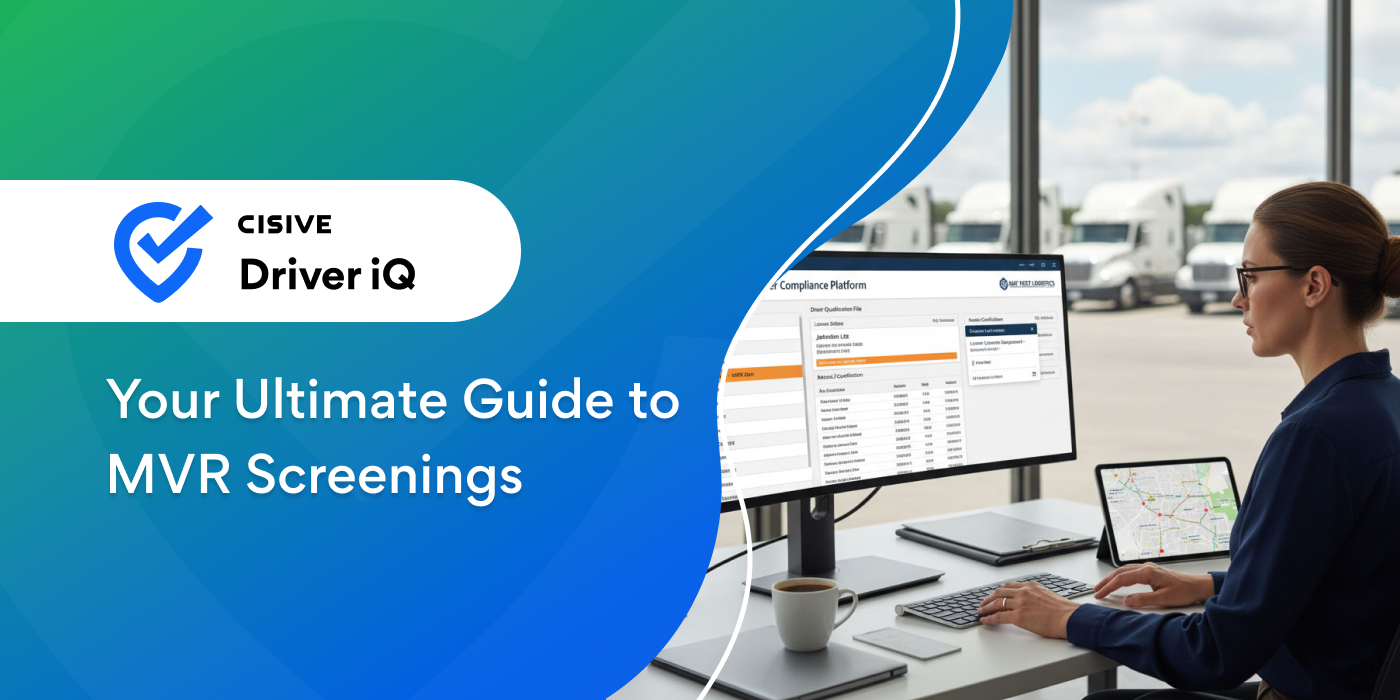
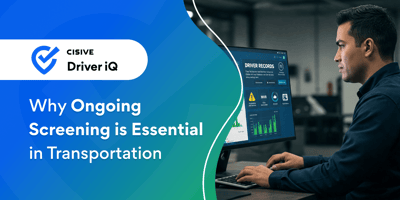
You don't always know what your drivers do when they're off the clock, but those actions could...

Hiring a commercial driver means placing your company’s reputation and safety on the road every day. It is essential to verify that each commercial driver holds a valid commercial driver's license, as this is a critical factor in ensuring compliance and safety. A single unqualified driver can create compliance violations, costly accidents, and liability that puts your business at risk. That’s why motor vehicle record (MVR) screenings are a foundational step in building a safe, reliable, and compliant fleet.
Yet many employers underestimate the complexity of Department of Transportation (DOT) and Federal Motor Carrier Safety Administration (FMCSA) requirements or delay screenings until after an issue arises. In today’s competitive transportation industry, that reactive approach is no longer enough. With the right process and tools, you can protect your business, accelerate hiring, and gain confidence that every driver you employ meets federal and state standards.
This guide will help you understand what MVR screenings are, when to use them, and how they fit into a broader compliance strategy. MVR screening is a key component of pre employment screening and background screening for transportation roles, helping ensure comprehensive vetting and safer hiring decisions.
Key TakeawaysHere are the five key things to know about MVR screenings:
|
An MVR screening is a review of records pulled from state Department of Motor Vehicles (DMV) databases, which are retrieved using the driver's license number. For employers in trucking and transportation, these background checks are central to compliance and accident prevention. They confirm whether a driver has a valid commercial driver’s license (CDL), meets DOT and FMCSA safety requirements, and maintains a record free of disqualifying offenses.
These MVR reports are mandated under 49 CFR Part 391, which requires employers to review records from every state where a driver has held a license in the past three years. An MVR background check provides a motor vehicle report containing driving record information, such as violations, license status, and an individual's driving history. This process helps organizations maintain compliance, reduce liability, and protect themselves and the public. Driving record checks are also part of broader applicant screening programs that verify employment history, drug testing, and safety performance.
Every mile driven by a commercial driver carries risk. MVR screens act as a safeguard to protect employers, employees, and the public. Screenings help identify unsafe drivers before they are hired and ensure compliance with federal regulations.
MVR screenings are critical because of:
Safety: Detect patterns of risky driving, such as driving under the influence (DUI), reckless behavior, a history of serious accidents, or repeated moving violations.
Compliance: Ensure alignment with FMCSA requirements for pre-employment and annual checks.
Risk mitigation: Reduce exposure to lawsuits and liability claims.
Reputation: Demonstrate due diligence to insurers, regulators, and customers.
The process of running an MVR screening is straightforward and comprehensive. Employers pull records from state DMVs and national databases to confirm a driver’s qualifications and identify potential red flags.
Most MVR screenings include:
License class, endorsements, and restrictions
License status (valid, suspended, revoked, or expired)
Traffic violations and accident history
DUI/DWI convictions or other disqualifying offenses
Verification of medical certification status, as required under DOT rules
Checking against the CDLIS report to confirm a driver holds only one valid CDL
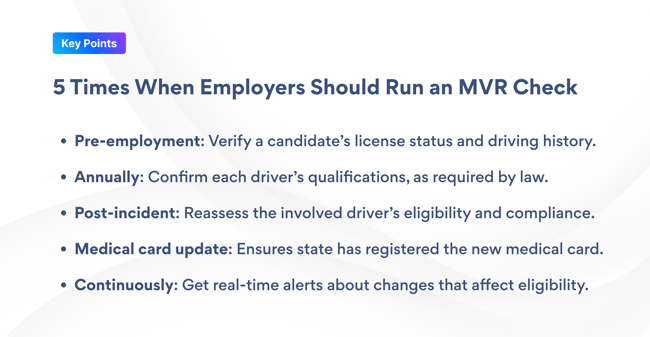
MVR screenings aren’t just for the hiring stage. To stay compliant and protect your business, employers must know when to run these checks. At a minimum, federal regulations require them during the hiring process and once every 12 months thereafter.
In practice, many employers are moving toward more frequent monitoring to catch risks before they become costly incidents.
Running MVR checks at the right times ensures your drivers remain qualified, compliant, and safe. Here are the most common touchpoints:
Pre-employment: Verifies a job candidate’s license status and driving history
Annually: Required by the FMCSA to confirm each driver’s qualification to operate a commercial vehicle
Post-incident: After an accident or violation, to reassess driver eligibility and compliance
After medical card update: Ensures the state has registered the updated medical card
Ongoing: Through continuous driver monitoring, which provides real-time alerts about changes in license status, violations, or medical certification
By adopting both scheduled and continuous MVR monitoring, employers can significantly reduce blind spots and keep unsafe drivers off the road.
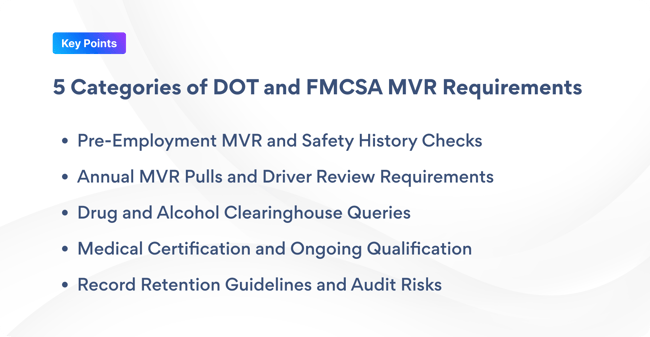
DOT and FMCSA regulations don’t leave room for guesswork. As an employer, you are legally responsible for verifying that every driver you place behind the wheel is qualified and compliant. The following requirements outline when to run MVR checks, what records to keep, and how to maintain files that will stand up in an audit.
Before allowing a driver to operate a commercial motor vehicle, you must obtain an MVR from every state where the driver has held a CDL or permit within the past three years (49 CFR §391.23). You are also required to investigate the driver’s safety performance history with previous DOT-regulated employers during that same period.
In practice, this means reaching out to past employers, verifying employment dates, and documenting any safety-related incidents. For instance, if a candidate worked in multiple states for multiple companies over three years, you’ll need to collect and review records from each state DMV and employer.
Under 49 CFR §391.25, you must request and review an updated MVR from every state where a driver has held a license in the past year. This review must happen at least once every 12 months.
Your role as the employer is to examine the record, identify new violations, suspensions, or disqualifications, and certify in writing that you’ve completed the review. For example, if a driver’s record shows multiple speeding violations that occurred post-hire, you need to document your evaluation and determine whether corrective action is required.
Employers who fail to conduct annual pulls risk fines and increased liability if an unqualified driver causes an accident.
The FMCSA Drug & Alcohol Clearinghouse is a mandatory step in the compliance process. Employers must run a full query before hiring a driver and a limited query at least once every 12 months for each current driver. These checks confirm whether a driver has unresolved drug or alcohol violations that would prohibit them from operating a commercial motor vehicle.
Your responsibility is twofold:
Register with the clearinghouse and gain driver consent for each query.
Document query results in the driver’s file to prove compliance during audits.
For example, if a driver failed a drug test with a prior employer and hasn’t completed the required return-to-duty process, they are ineligible to drive.
Drivers must meet DOT’s physical qualification standards and maintain a valid medical examiner’s certificate (MEC), which is linked directly to their CDL record under 49 CFR §391.41. You must ensure the driver’s medical certification is current and that a copy is kept in their driver qualification (DQ) file.
If a driver’s MEC expires, their CDL can be downgraded by the state licensing agency. Letting that driver continue operating creates compliance risks and potential liability for your company. For example, if a driver’s certificate lapsed last month and they were involved in an accident today, regulators could hold your business accountable for permitting a disqualified driver to operate.
To avoid surprises, many carriers implement proactive tracking systems that flag upcoming expiration dates and ensure drivers complete their medical exams on time.
FMCSA requires you to maintain certain records in a DQ file for each driver, including:
The driver’s initial three-year pre-employment MVRs.
Each annual MVR.
Your signed note from the annual review.
Companies must retain these documents for at least three years and make them readily available for inspection under 49 CFR §391.51.
In an audit, inspectors often start by reviewing your DQ files. Even one missing annual MVR can raise a red flag and potentially trigger penalties. Many employers reduce this risk by centralizing records through employment verifications. Doing so streamlines information collection and ensures audit readiness.
Failing to run thorough MVR screenings puts safety at risk and exposes your business to serious financial and operational consequences. According to FMCSA, motor carriers can face civil penalties of up to $16,000 per violation for allowing a disqualified driver to operate a commercial vehicle. Gaps in compliance can also lead to out-of-service orders that disrupt operations and erode customer trust.
The business impact can go even deeper. Inadequate screening can drive up insurance premiums, increase accident-related costs, and damage your company’s reputation with shippers and regulators. If an overlooked license suspension contributes to even a single preventable crash, your company can face lawsuits, settlement costs, and long-term brand harm. By contrast, consistent MVR compliance signals diligence to regulators and insurers, which can protect your bottom line.
Managing MVR requirements across multiple states and agencies can overwhelm even experienced compliance teams. Cisive Driver iQ simplifies this complexity by automating MVR pulls, integrating drug and alcohol testing, and consolidating safety history into a single, audit-ready platform.
The benefit for employers is protection and peace of mind. By partnering with Driver iQ, you gain real-time visibility into driver eligibility, reduce manual paperwork, and cut down on turnaround times that delay hiring. Automated alerts help you act quickly whenever a driver’s license status changes, while integrated drug testing ensures you never miss a compliance requirement.
The results: fewer blind spots, stronger risk management, and a more reliable fleet.
Consistent MVR screening protects your business, improves audit outcomes, and builds trust with customers and regulators. Driver iQ makes that consistency practical, helping your team move faster with fewer blind spots. Ready to see it in action? Speak to a Driver iQ expert and start building a safer, more compliant fleet.
Author: Michael Kapuschinsky
Bio: Product Manager with more than a decade of experience in the transportation industry.
Let's Connect on LinkedIn
You don't always know what your drivers do when they're off the clock, but those actions could...
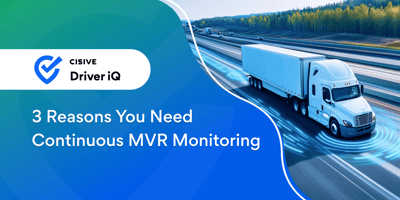
Keeping your fleet safe requires more than periodic checks. A real time MVR monitoring program...

Safety is a top priority in the transportation and trucking industry. A key tool for risk...